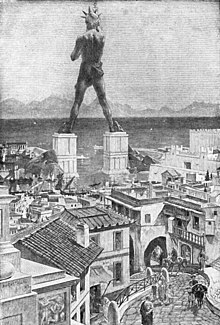Spoke 7: The Biblewheel and The 7th Century
(Go back to main Menu)
Colossus of Rhodes Metal Melted and Sold
Although the Colossus of Rhodes was long destroyed after an earthquake, once the caliph Muawiyah had taken possession of Rhodes the Muslims, it is said, that they sold the parts away. And although there is no connection between the Colossus of Rhodes and the city of Colossae
https://en.wikipedia.org/wiki/Colossus_of_Rhodes
(Go back to main Menu)
Colossus of Rhodes Metal Melted and Sold
Although the Colossus of Rhodes was long destroyed after an earthquake, once the caliph Muawiyah had taken possession of Rhodes the Muslims, it is said, that they sold the parts away. And although there is no connection between the Colossus of Rhodes and the city of Colossae
Colossus of Rhodes
Construction
Preserved in Greek anthologies of poetry is what is believed to be the genuine dedication text for the Colossus.[8]
Destruction
The statue stood for 54 years until Rhodes was hit by the 226 BC earthquake, when significant damage was also done to large portions of the city, including the harbour and commercial buildings, which were destroyed.[10]The statue snapped at the knees and fell over onto the land. Ptolemy III offered to pay for the reconstruction of the statue, but the oracle of Delphi made the Rhodians afraid that they had offended Helios, and they declined to rebuild it.
The remains lay on the ground as described by Strabo (xiv.2.5) for over 800 years, and even broken, they were so impressive that many travelled to see them. Pliny the Elder remarked that few people could wrap their arms around the fallen thumb and that each of its fingers was larger than most statues.[11]
In 653, an Arab force under Muslim caliph Muawiyah I captured Rhodes, and according to The Chronicle of Theophanes the Confessor,[12] the statue was melted down and sold to a Jewish merchant of Edessa who loaded the bronze on 900 camels.[13] The Arab destruction and the purported sale to a Jew possibly originated as a powerful metaphor for Nebuchadnezzar's dream of the destruction of a great statue.[14]
The same story is recorded by Bar Hebraeus, writing in Syriac in the 13th century in Edessa:[15] (after the Arab pillage of Rhodes) "And a great number of men hauled on strong ropes which were tied round the brass Colossus which was in the city and pulled it down. And they weighed from it three thousand loads of Corinthian brass, and they sold it to a certain Jew from Emesa" (the Syrian city of Homs). Theophanes is the sole source of this account and all other sources can be traced to him.
https://en.wikipedia.org/wiki/Colossus_of_Rhodes
![Biblewheel: A wise king scattereth the wicked, and bringeth the wheel over them. [Pro 20:26 KJV]](https://blogger.googleusercontent.com/img/b/R29vZ2xl/AVvXsEgiFT6-YCyrSoMjVlsXjQIWJVHaMXsChgqmAIk9mLeNmsgqWXD94k5TOPejvnORdnQ39OL3U4FleKWbC1r46q2t5nYnipb_qDZFNHQR_YXesnm6ucYt2g1DjbBhXnZmML3IHhunsYSeRBU/s1600-r/biblewheel_traced_edited.png)

No comments:
Post a Comment